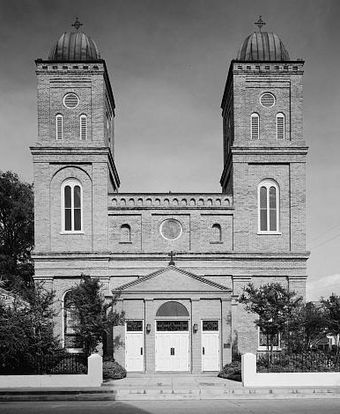Natchitoches Historic District facts for kids
|
Natchitoches Historic District
|
|

Church of the Immaculate Conception
|
|
| Location | Natchitoches, Louisiana |
|---|---|
| Area | 280 acres (110 ha) |
| Architectural style | Late Victorian, Colonial, Bungalow/craftsman, Queen Anne |
| NRHP reference No. | 74000928 (original) 80001740 (increase) |
Quick facts for kids Significant dates |
|
| Added to NRHP | June 5, 1974 |
| Boundary increase | November 25, 1980 |
| Designated NHLD | April 16, 1984 |
The Natchitoches Historic District is a very special area in Natchitoches, Louisiana. It's also known as the Natchitoches National Historic Landmark District. This district protects the heart of Natchitoches, which is the oldest European settlement in what is now Louisiana. It's even the oldest European settlement in the larger area of the Louisiana Purchase.
French explorers founded Natchitoches in 1714. The name "Natchitoches" is pronounced NAK-ə-təsh. It comes from the name of the Native American people who lived in the area. In 1984, this important district was named a National Historic Landmark. This means it's a place recognized for its special history in the United States.
Contents
History of Natchitoches
How Natchitoches Started
The city of Natchitoches was first built on the banks of the Red River. This spot was important because it was where boats could no longer travel further up the river. It was located in northern Louisiana, between the cities of Alexandria and Shreveport.
French explorers founded Natchitoches in 1714. They wanted to make sure France had a strong claim to this land. This was important because Spain also claimed parts of the area.
A Busy Trading Center
Natchitoches grew into a very important trading center. Goods were traded between the French, the Spanish, and the local Native American tribes. The city's oldest streets were built parallel to the river. Roads connecting Natchitoches to other places also grew after France gave Louisiana to Spain in 1763.
Natchitoches stayed a key trading hub for many years. But in the early 1800s, something big happened. The Red River changed its path and moved eastward. This left the downtown area of Natchitoches next to the old river channel. This old channel is now called the Cane River.
Why the District is Preserved
When the river changed course, it stopped a lot of new building in Natchitoches. This was actually a good thing for history! It helped to keep many of the city's 18th-century buildings and its old-town feel. Because of this, we can still see much of its original character today.
The historic district covers areas on both sides of the old river channel. On the east side, it includes properties along Williams Street. On the west side, it stretches for several blocks, from the Keyser Street bridge in the south to Texas Street in the north.
There are more than 200 historic buildings in the district. Many of these old buildings from the 1700s and early 1800s were built using a French colonial method called bousillage. This is a building technique that uses a mix of mud, moss, and animal hair to fill in walls.
Saving History
A person named Robert DeBlieux was very important in creating this historic district. He was a preservationist, meaning he worked to protect historical places. He also served as the mayor of Natchitoches from 1976 to 1980. His efforts helped make sure this special area was protected for future generations.
Important Buildings
One of the important buildings in the district is the Basilica of the Immaculate Conception. It is also known as the Church of the Immaculate Conception.



